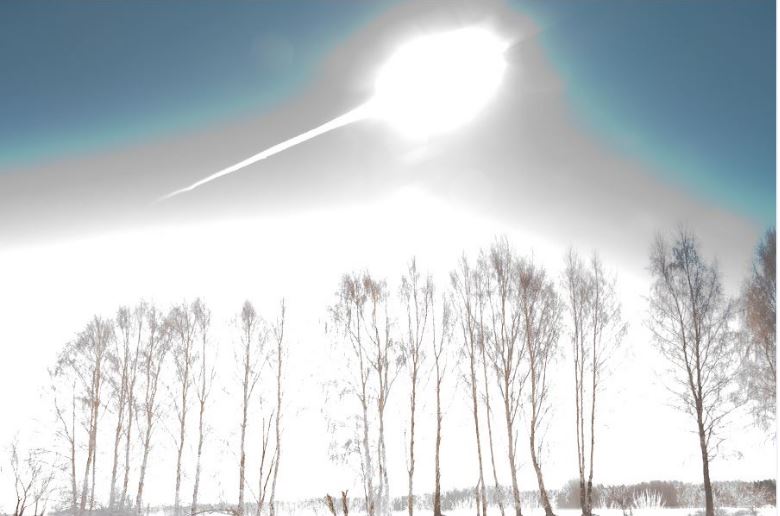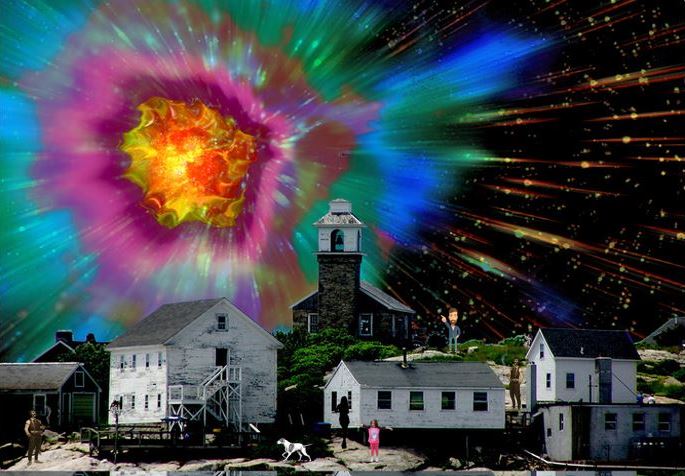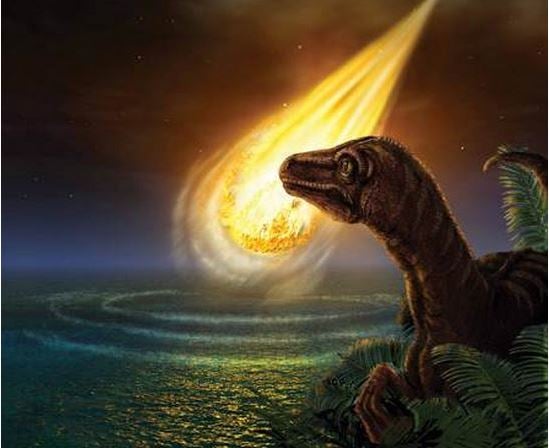What would we do if a killer asteroid came our way – in a head-on collision with Earth? NASA and FEMA carried out a drill on precisely that scenario on October 25th in El Segundo, California. Experts say that Earth has had several killer asteroid impacts, and will definitely have more throughout its existence. The question is not ‘if’ we ever get hit but ‘when’.
What exactly would we be able to do if we discovered that a large asteroid capable of destroying millions of people, our civilization, or even life as we know it was heading straight towards us? During the tabletop exercise FEMA and NASA said they gained valuable experience.
NASA and FEMA (Federal Emergency Management Agency) said their third in a series of joint exercises was designed to strengthen the collaboration between the two US agencies.
 The Chelyabinsk meteor entered Earth’s atmosphere over Russia in February 2013. It was just 17 meters across and injured 1,491 people, including 311 children. A total of 7,200 buildings were damaged and 100,000 homeowners were affected. Its route meant that we were unable to detect it until it was literally right on top of us. Imagine what an asteroid 250 meters across could do! (Image: apod.nasa.gov)
The Chelyabinsk meteor entered Earth’s atmosphere over Russia in February 2013. It was just 17 meters across and injured 1,491 people, including 311 children. A total of 7,200 buildings were damaged and 100,000 homeowners were affected. Its route meant that we were unable to detect it until it was literally right on top of us. Imagine what an asteroid 250 meters across could do! (Image: apod.nasa.gov)
Humans vs. killer asteroid
When the killer asteroid crashed off what is today the Yucatan Peninsula sixty-five million years ago, and probably wiped out the dinosaurs, there was nothing any life form on Earth could have done to prevent it. This is not the case today – if we all cooperate, we have the ability to either prevent an impact or at least save millions of lives.
Thomas Zurbuchen, Associate Administrator for NASA’s Science Mission Directorate in Washington, explained:
“It’s not a matter of if – but when – we will deal with such a situation. But unlike any other time in our history, we now have the ability to respond to an impact threat through continued observations, predictions, response planning and mitigation.”
The simulation provided a forum for the planetary science community to demonstrate how it would gather, analyze and share data about a fictional killer asteroid predicted to crash into the Earth.
Emergency managers exchanged ideas during the simulation on how that data could be utilized to consider some of the unique challenges an asteroid impact would present. The aim was to determine how we would prepare for it, respond, and warn the general public.
 Even with our latest technology, there are still killer asteroids that we are unable to detect until it is too late.
Even with our latest technology, there are still killer asteroids that we are unable to detect until it is too late.
FEMA Administrator Craig Fugate said:
“It is critical to exercise these kinds of low-probability but high-consequence disaster scenarios. By working through our emergency response plans now, we will be better prepared if and when we need to respond to such an event.”
The event was attended by representatives from FEMA, NASA, the Jet Propulsion Laboratory, the US Air Force, the California Governor’s Office of Emergency Services, and the Department of Energy’s National Laboratories.
Imagine a killer asteroid strikes in 2020
The participants were presented with a killer asteroid scenario in which the celestial object was discovered now and was predicted – with a 2% probability – to crash into Earth on September 20th, 2020.
This pretend-asteroid was estimated to be from 300 to 800 feet (100 to 250 metres) across. Scientists had informed that the impact could occur anywhere on our planet’s surface.
During the simulation, participants continued tracking the giant rock for three months using ground-based telescopes. During this period the likelihood of a direct hit increased to 65%.
Then the asteroid moved into a position relative to the Sun which meant that it could not be observed for four months. In May 2017, when it could be observed again – the probability of it crashing into Earth jumped to one-hundred percent!
In November 2017, scientists were predicting that impact would occur either in the Pacific Ocean near the Californian coast or in a narrow band across Southern California.
NASA’s New Asteroid Alert System Gives 5 Whole Days Of Warning: https://t.co/pqMvuLS7qX pic.twitter.com/ZMSpQhdplx
— World and Science (@WorldAndScience) November 4, 2016
Killer asteroid deflection not possible
In the previous simulations, the possibility of mounting a deflection mission to move the killer asteroid off its collision course with Earth had been a possibility, but not this time. In this tabletop exercise, the simulation was designed so that there was not enough time for a deflection mission to be mounted.
In this exercise, southern California emergency managers were faced with a mass evacuation of tens of millions of people.
Researchers from The Aerospace Corporation, Sandia National Laboratories, JPL, and Lawrence Livermore National Laboratory presented population displacement estimates, predicted impact footprint models and information on affected infrastructure, as well as other data related to a killer asteroid impact.
FEMA National Response Coordination Branch Chief Leviticus A. Lewis, said:
“The high degree of initial uncertainty coupled with the relatively long impact warning time made this scenario unique and especially challenging for emergency managers. It’s quite different from preparing for an event with a much shorter timeline, such as a hurricane.”
The participants considered how to provide timely, accurate and useful information to the public, while at the same time addressing how to refute false information and rumors that would emerge during the four years before the killer asteroid impact.
 Asteroids travel at an average speed of about 25 kilometers per second (15.5 mps), or 90,000 kph (55,923 mph). Some have been observed doing 30 kilometers per second (18.6 mps), or 108,000 kph (67,108 mph). (Image: nasa.gov)
Asteroids travel at an average speed of about 25 kilometers per second (15.5 mps), or 90,000 kph (55,923 mph). Some have been observed doing 30 kilometers per second (18.6 mps), or 108,000 kph (67,108 mph). (Image: nasa.gov)
NASA Planetary Defense Officer Lindley Johnson, said:
“These exercises are invaluable for those of us in the asteroid science community responsible for engaging with FEMA on this natural hazard. We receive valuable feedback from emergency managers at these exercises about what information is critical for their decision making, and we take that into account when we exercise how we would provide information to FEMA about a predicted impact.”
 According to William K. Hartman, from the Planetary Science Institute, there is abundant geological evidence that the asteroid that scientists believe wiped out the dinosaurs was about 10 kilometers (6 miles) across. The explosion led to the extinction of approximately three-quarters of all species that existed at that time.
According to William K. Hartman, from the Planetary Science Institute, there is abundant geological evidence that the asteroid that scientists believe wiped out the dinosaurs was about 10 kilometers (6 miles) across. The explosion led to the extinction of approximately three-quarters of all species that existed at that time.
What is an asteroid?
An asteroid is an irregularly shaped, small, rocky object in our Solar System – it orbits the Sun. It is made from leftover rock and other material from the creation of the Solar System. The celestial objects that were formed were not large enough to create planets.
The word ‘asteroid’ in Ancient Greek means ‘like a star’, which makes sense because they do look like stars in the sky to the naked eye. However, they are nothing like stars.
Giuseppe Piazzi (1746-1826), an Italian priest and astronomer, was the first human to discover and name an asteroid – Ceres. It was found orbiting between Jupiter and Mars. Today, Ceres is classed as a dwarf planet.
 A killer asteroid is one that could kill thousands, millions or billions of people. NASA says that a car-sized asteroid hits Earth’s atmosphere about once a year. A meteoroid about the size of a football field hits our planet every 2,000 or so years, causing significant damage to the area. An object large enough to threaten our civilization crashes into the Earth once ever few million years.
A killer asteroid is one that could kill thousands, millions or billions of people. NASA says that a car-sized asteroid hits Earth’s atmosphere about once a year. A meteoroid about the size of a football field hits our planet every 2,000 or so years, causing significant damage to the area. An object large enough to threaten our civilization crashes into the Earth once ever few million years.
Scientists are currently discovering thousands of new asteroids each month thanks to computerized telescopes.
Asteroids can range in size from 1 meter to hundreds of kilometers across. Some of them are so big that they have their own moon. Killer asteroids are the larger ones that can destroy life on Earth in a big way.
Asteroid vs. Comet: asteroids consist of metals and rocky material, while comets are made of ice, dust and rocky material. Asteroids were formed much closer to the sun, where it was too hot for ices to remain solid.
When comets get near the Sun, they lose material with each orbit because some of their ice melts and turns into vapor.
Most asteroids exist in the asteroid belt, a region between Jupiter and Mars. Most comets, on the other hand, are in the farthest reaches of our Solar System.
Video – Killer asteroid simulation
This Discovery Channel asteroid simulation shows what would happen if a celestial object 500 km across crashed into the Pacific Ocean. The 10 km crust of the surface of the Earth would be peeled off. A firestorm would encircle our planet, vaporising all life in its way. The Earth would be uninhabitable within twenty-four hours. Scientists believe this has happened at least six times in Earth’s history.
